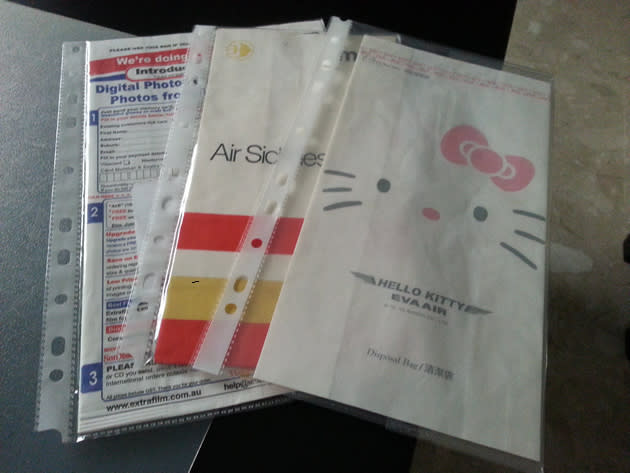This Singaporean collects vomit bags as a hobby

Do people in Singapore do more than just the usual things like shopping, surfing the web or watching movies? In a multi-part series, Yahoo! Singapore talks to people with very odd hobbies and how they got into them.
Whenever Chen Yinghao flies, the first thing he does while onboard an aircraft carrier is to look for the vomit bags – and it’s not because he is afraid of flying or has air sickness.
The 30-year-old has a love for vomit bags and is part of a very small community of vomit bag collectors around the world calling themselves “baggists”.
One of two baggists in Singapore, Chen has amassed close to 600 barf bags from over 200 airlines, including Singapore Airlines and the now-defunct Balkan Bulgarian Airlines.
By day, he works as a marketing brand executive for a pharmaceutical company. By night, he trawls eBay and online barf bag websites for potential purchases or swaps with other baggists.
It all started 13 years ago, when he went on a trip to Nepal for his junior college's community improvement project. On board a Nepal Airlines aeroplane (formerly known as Royal Nepal Airlines), Chen got bored and started to look through the seat pocket in front of his seat. Intrigued by the empty barf bag that bore the airline’s logo, he thought he could start a new collection that no one else would think about collecting.
“I thought the hobby would be something unusual – like something that nobody will ever think about collecting because these bags are easily missed as it doesn’t serve many purposes,” Chen said.
So how does he collect these bags?
Conversation-starter
Of his 600-odd sick sacks, only about less than 10 per cent are collected by him when he goes travelling. About half of his collection is contributed by his family, friends and colleagues while the remaining comes from swaps from baggists from other countries.
To Chen, the hobby can be a way to socialise as it requires him to talk to people and get them to help him out by adding to his collection.
“I don’t get to fly often, maybe once or twice a year so I tap on my friends. When they fly, they will take some for me,” Chen said.
“Sometimes when my friends give me bags and they fold it to keep it in their bags, I get a little sad because it will not be in mint condition anymore. But I’m too paiseh (Hokkien for embarrassed) to give them specific instructions when they are helping me obtain these bags,” he added.
The hobby is also a great conversation starter whenever he meets new people.
“People go ‘What? Barf bags?’ when I tell them I collect these bags. They think it’s an unusual and unconventional hobby and ask me many questions,” he said.
Some nice Singaporeans have also contacted Chen, after seeing his website displaying his collection, saying that they've collected some air sickness bags for him when they were travelling and would mail it to him.
Comparing and preserving
Once he gets his hands on a new bag, Chen will studiously examine its condition, if it has yellowed or if is torn. Then he will put it side-by-side to compare it with a previous version.
“There are a lot of things to note on the bags. Some are very colourful, some can tell a lot about certain airlines – their company image, and how they want to be seen. We even look at the size and material used and keep ourselves updated on changes made to their vomit bags,” he said.
After that’s done, Chen will meticulously keep them in transparent sheet protectors, tape the excess plastic in and label the folder with the airline’s name, when he obtained the bag and how he obtained it.
The final step is to keep them in alphabetical order in white IKEA boxes – those with air-proof clasps to prevent yellowing or moulding – before stowing them away in a room at his humble home in Woodlands.
Chen who is due for Kuala Lumpur in February, deliberately chose to take Malaysia Airlines just to see if the airline has updated the design for their vomit bags.
“I believe they procure these bags in bulk to make it cheap. When their bags run out, they might change the design. I got my last Malaysia Airlines bag three years ago, so they should have changed by now,’ Chen said.
Demand for Asian bags
There are about 80 known baggists in the world, and about less than 20 are from Asia. Most of the collectors are men between the ages 30 and 60 from the States or Europe.
Thanks to the booming aviation industry in Asia, though, barf bags from Asian airlines are in demand right now.
Three years ago, Chen visited Myanmar and had the opportunity to fly on Air Bagan, a domestic airline within Myanmar.
“An ex-colleague helped me and we practically took all the bags from the plane we were on. Every bag on the plane,” Chen said.
“We went seat by seat after landing and just took all the unused bags. It became my stash to trade with others because most baggists are Westerners living in the United States or Europe and they hardly travel to Asia,” he added.
From that stash of Air Bagan vomit bags, Chen traded with other baggists and increased his collection by a fair bit.
“In Europe and the States, the aviation industry is very competitive so there are hardly any new airlines or new additions to the market,” Chen noted.
“Because of a recent open-skies policy, many new airlines are popping up especially in Southeast Asia. In the future we can expect more airlines and more barf bags coming out of Asia,” he said.
Related stories:
Is being a flight attendant all that glamorous?




